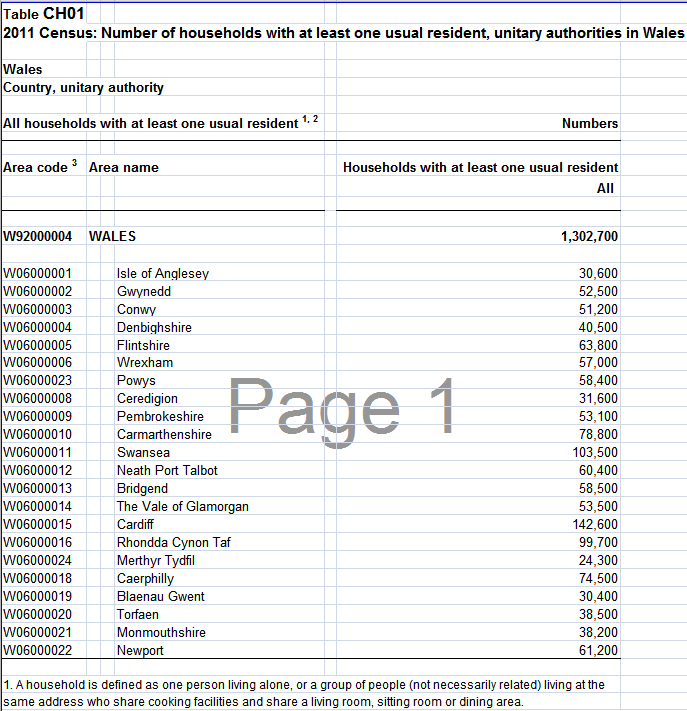In a number of recent posts – work back from here – I have criticised the projections made by the Knowledge and Analytical Services (KAS), a unit based in Cardiff but answering to the Department for Communities and Local Government (DCLG) in London. These projections have raised questions as to their reliability and true purpose, especially when used by the Planning Inspectorate (an ‘executive agency’ of the same DCLG) to force on our local authorities tens of thousands of new homes for which there is no perceptible Welsh demand. We have thankfully reached the stage where no matter how abstruse the subject matter, or obtuse some of our politicians, it is now difficult for anyone to justify most of the new housing demanded.
 In particular, I sought to explain the significance of household size; that is, how many individuals make up a household. Because linking household size with projected increases in population is the basis for determining how many new homes will be needed.
In particular, I sought to explain the significance of household size; that is, how many individuals make up a household. Because linking household size with projected increases in population is the basis for determining how many new homes will be needed.
The KAS had previously projected a household size for 2008 of 2.27 reducing to 2.02 by 2033, with a figure for 2011 of 2.23. The Census showed that the figure for 2011 was in fact 2.31. Which meant that the KAS had to revise its figures, which now project household size reducing from 2.31 in 2011 to 2.23 in 2026 (and 2.18 in 2036). (See KAS table, click to enlarge.) Quite a difference across Wales. As I said in an earlier post: “This difference of .08 (for 2011) may seem unimportant . . . until you remember that it equates to 46,764 dwellings and (x 2.31) a population of 108,025. To put that into perspective, at the 2011 Census there were just 31,600 households in Ceredigion”. The KAS document can be read below.
[gview file=”https://jacothenorth.net/blog/wp-content/uploads/Household-projections-2011.pdf”]
The projected population levels have also been brought down. The figure now being quoted, for 2012 to 2037, is for an increase in Wales’ population of just 247,000. To give some idea of the recalculation involved, just two years earlier the same statisticians were projecting a population increase of 363,000 between 2010 and 2035.
So we see that in a matter of two years the projected population increase is down and the household size is up, which must result in far fewer dwellings being needed over the next 25 years than was previously argued for. A simple calculation would suggest that over that period, and by dividing population increase by household size, Wales will need something like 112,000 new dwellings. Obviously there are other factors to be taken into account that will increase that figure, but one thing’s for sure – Wales does not need anything like the figure of 331,168 new dwellings being bandied about by Carl Sargeant as recently as last autumn. It’s time for a re-think.
Nowhere is this re-think more needed than in Denbighshire. (I know I bang on a bit, but I’ve got a soft spot for Denbighshire, though not its ruined coast, obviously.) The clip below from the BBC (click to enlarge) tells us that last year Denbighshire was forced by a Planning Inspectorate inspector to build 8,500 new homes in the LDP covering the period 2006 to 2021. Yet according to the latest figures (2011) produced by the Knowledge and Analytical Services the county’s population will increase by only 4,134 between 2011 and 2021. Yippee! Everybody will have two homes!
Clearly, the new housing for Denbighshire is overwhelmingly speculative building. Which also goes a long way to explaining the plans for Flintshire and Wrecsam. This is the Mersey-Dee conspiracy in operation. Our north east being used to protect property values in Wilmslow, Prestbury and elsewhere by directing the less well-heeled commuters for Liverpool and Manchester over the border, helped by estate agents advertising properties in Wrecsam as ‘Wes t Cheshire’.
t Cheshire’.
This helps explain the anomaly of the KAS projecting huge percentage increases in the numbers living alone, and childless (elderly) couples – groups that would obviously need one- and two-bedroom properties – to justify the large numbers of new dwellings needed . . . yet after ‘consultations’ with the Planning Inspectorate and the Home Builders Federation what emerges is a deluge of planning applications for three- and four-bedroom houses!
All of which makes the motives of those arguing for extravant numbers of new dwellings deeply suspect. Greedy developers cannot be entirely blamed. Which is why I suspect there are darker motives at work; essentially an attempt to change an area’s – and eventually a country’s – character, identity, and loyalty. I may be right, I may be wrong; but it is now established beyond any doubt that the figures and projections used to intimidate Welsh councils into building homes we don’t need were most definitely wrong. Which means that the Local Development Plans are discredited. All must be scrapped.
No new development plans should be drawn up until we have had local government reorganisation. There is no reason to delay this reorganisation any longer, nor is there any good reason to get it wrong (again) by insisting that it can only be done by mergers within existing boundaries, or that the proposed new councils must stick to police force or health board boundaries. Five years from now we could have a national police force and just one health board for the whole country.
But while the future is always difficult to discern, the past, and the statistics produced in recent years by the Knowledge and Analytical Services – the figures that informed the Local Development Plans – are glaringly clear – and they are wrong! To continue as if they were right, and that nothing has changed, would be further proof of the “darker motives” I referred to above.

